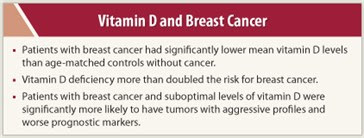- Researchers have discovered a way in which one of the deadliest and most difficult to treat breast cancers allows tumor cells to grow unchecked and how these tumors resist treatment. Specifically, they found that BRCA1-deficient cells activate CTSL which leads to lower levels of the protein 53BP1 which, in turn, allows cancer cells to grow unchecked.
- In addition, they discovered the potential for a new therapy involving vitamin D, and identified biomarkers that can help identify which patients could benefit from this therapy.
- In the future, women with triple-negative breast cancer may benefit from a treatment that includes vitamin D. As with all laboratory research, vitamin D therapy will have to be studied in a clinical trial before doctors know how safe or effective it will be.
- Researchers’ next steps will be to study molecular mechanisms behind the activation of the degradation of 53BP1 by CTSL. In addition, preclinical studies with vitamin D and cathepsin inhibitors as single agents or in combination with different drugs are underway in mouse models of breast cancers.
Taking you through my Journey to bring much awareness to Breast Cancer and that Early Detection is key to survival.
I promise
"I promise, Suzy... Even if it takes the rest of my life." -Nancy G. Brinker, Founder of Susan G. Komen for the Cure
What is TNBC
WHAT IS TRIPLE NEGATIVE BREAST CANCER?
Just in recent years, Triple Negative Breast Cancer (TNBC) has sparked interest in the news where instead of calling the tumor as ER-negative, PR-negative, and HER2-negative; researchers began using the shorthand term, "Triple Negative," dubbed the "new type" of breast cancer. Being Triple Negative, you don't have a targeted therapy and your only treatment option is chemotherapy.
Triple Negative Breast Cancer is seen in about 15% of all breast cancers. TNBC is a very aggressive cancer that tends to strike younger women, pre-menopause, especially among African-American women and women who have BRCA1 mutations. The tumor tends to be fast growing and is less likely to show up on an annual mammogram. TNBC is more likely to metastasis early on; has a high rate of recurrence in the first 2-3 years from diagnosis and has a poorer prognosis than other types of breast cancer due to lack of specific, targeted treatment for TNBC.
Wednesday, January 23, 2013
Vitamin D Holds Promise In Fighting Triple Negative Breast Cancer
Total Pageviews



